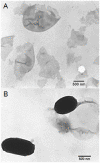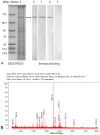Detection of B. anthracis spores and vegetative cells with the same monoclonal antibodies
- PMID: 19915677
- PMCID: PMC2773009
- DOI: 10.1371/journal.pone.0007810
Detection of B. anthracis spores and vegetative cells with the same monoclonal antibodies
Abstract
Bacillus anthracis, the causative agent of anthrax disease, could be used as a biothreat reagent. It is vital to develop a rapid, convenient method to detect B. anthracis. In the current study, three high affinity and specificity monoclonal antibodies (mAbs, designated 8G3, 10C6 and 12F6) have been obtained using fully washed B. anthracis spores as an immunogen. These mAbs, confirmed to direct against EA1 protein, can recognize the surface of B. anthracis spores and intact vegetative cells with high affinity and species-specificity. EA1 has been well known as a major S-layer component of B. anthracis vegetative cells, and it also persistently exists in the spore preparations and bind tightly to the spore surfaces even after rigorous washing. Therefore, these mAbs can be used to build a new and rapid immunoassay for detection of both life forms of B. anthracis, either vegetative cells or spores.
Conflict of interest statement
Figures








References
-
- Ash C, Collins MD. Comparative analysis of 23S ribosomal RNA gene sequences of Bacillus anthracis and emetic Bacillus cereus determined by PCR-direct sequencing. FEMS Microbiol Lett. 1992;73:75–80. - PubMed
Publication types
MeSH terms
Substances
LinkOut - more resources
Full Text Sources
Other Literature Sources

